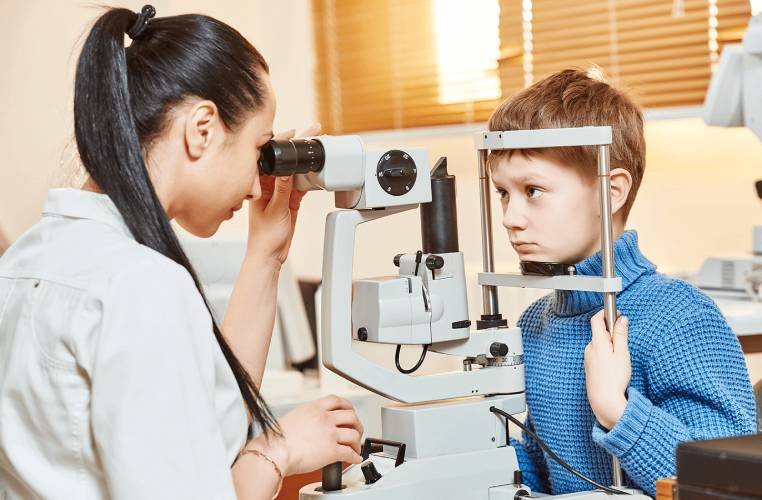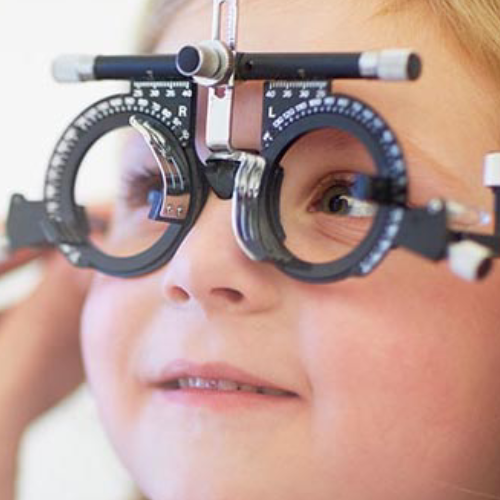About Pediatric Ophthalmology
Pediatric ophthalmology is a specialized branch of ophthalmology dedicated to diagnosing, treating, and managing eye conditions in infants, children, and adolescents. This field addresses a variety of visual and ocular issues that are unique to the pediatric population. Key aspects of pediatric ophthalmology includ.
Symptoms of Pediatric Ophthalmology
- Blurry or Cloudy Vision
- Difficulty Seeing at Night
- Increased Sensitivity to Light
- Faded or Yellowed Colors
- Double Vision
- Frequent Changes in Glasses or Contact Lens Prescription
- Difficulty with Daily Activities
- Halo Effect Around Lights
- Frequent Need for Better Lighting
- Gradual Loss of Vision Sharpness

Causes of Pediatric Ophthalmology
Amblyopia (Lazy Eye):
- A condition where one eye has reduced vision that is not correctable by glasses or contact lenses, often due to misalignment or unequal refractive errors.
Congenital Cataracts:
- Clouding of the lens present at birth, which can affect vision development if not treated early.
Congenital Glaucoma:
- A condition present at birth where increased intraocular pressure can damage the optic nerve and affect vision.
Blocked Tear Ducts:
- Nasolacrimal Duct Obstruction: A common issue in infants where the tear duct is blocked, leading to excessive tearing and potential infection.
Retinopathy of Prematurity (ROP):
- A condition affecting premature infants where abnormal blood vessels grow in the retina, which can lead to vision problems or blindness.
Optic Nerve Disorders:
- Conditions affecting the optic nerve, such as optic nerve hypoplasia or optic neuritis, which can impact vision.
Eye Infections and Inflammations:
- Conditions like conjunctivitis (pink eye), blepharitis, or uveitis that can affect the eye’s health and vision.

Treatments
Refractive Errors:
- Glasses: Prescribed to correct vision problems like myopia, hyperopia, or astigmatism.
- Contact Lenses: May be recommended for older children who are not suitable for glasses or prefer contact lenses.
Strabismus (Eye Misalignment):
- Glasses: Special lenses can sometimes correct or reduce the misalignment.
- Prism Lenses: To help align the visual fields.
- Eye Exercises: Vision therapy to strengthen eye muscles and improve coordination.
- Surgery: To correct the muscle imbalance causing the misalignment.
Amblyopia (Lazy Eye):
- Patch Therapy: Covering the stronger eye with a patch to encourage the weaker eye to work harder and improve vision.
- Atropine Drops: Used in the stronger eye to blur vision and force the weaker eye to improve.
- Vision Therapy: Exercises to improve coordination and visual skills.
When You Need
Treatment Pediatric Ophthalmology



Vision Problems:
- Difficulty Seeing Clearly: If the child has trouble seeing objects at a distance (myopia) or up close (hyperopia), or if they squint or close one eye frequently.
- Blurry Vision: Complaints of blurry or distorted vision, which could indicate refractive errors or other issues.
Eye Misalignment (Strabismus):
- Crossed Eyes: If one or both eyes turn inward, outward, upward, or downward.
- Inconsistent Eye Movement: If the eyes do not move together or if there is noticeable misalignment.
Eye Discomfort or Pain:
- Pain or Irritation: If the child complains of eye pain, itching, or discomfort that persists.
- Frequent Complaints: Regular complaints of discomfort, redness, or sensitivity to light.
frequently asked questions
Pediatric ophthalmology is a subspecialty of ophthalmology focused on the diagnosis and treatment of eye conditions in children. This can include vision issues, eye alignment problems, eye infections, and other conditions affecting children’s eyes.
Common conditions include amblyopia (lazy eye), strabismus (eye misalignment), congenital cataracts, and retinal disorders. Pediatric ophthalmologists also address refractive errors like nearsightedness, farsightedness, and astigmatism.
Signs of vision problems in children can include squinting, frequent rubbing of the eyes, difficulty seeing at a distance, trouble reading or recognizing faces, and avoidance of activities that require visual focus. If you notice these signs, it’s important to consult a pediatric ophthalmologist.
Treatments vary depending on the condition and may include corrective lenses, eye patches, medications, or surgery. For conditions like strabismus, specialized exercises or surgical intervention may be recommended. Pediatric ophthalmologists tailor treatment plans to each child’s specific needs to improve visual function and overall eye health.
24 / 7 HOURS SERVICE
